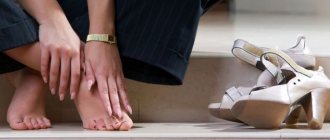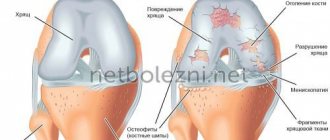There are several reasons for pain in the lower leg area. Here are some of them:
- injury,
- spasm,
- stretching,
- muscle pain after exercise,
- flat feet,
- varicose veins of the lower extremities,
- thrombosis of the veins of the leg,
- obliterating atherosclerosis of the arteries of the lower extremities,
- arterial thrombosis.
The most common causes of acute pain in the lower leg are:
- injury,
- spasm,
- sprain of the musculo-ligamentous apparatus of the leg,
- muscle pain after exercise.
As a rule, in this case, pain in the lower leg appears immediately or after a short period of time after an injury or physical effort. As a rule, such pain goes away within a few hours or days, without leaving any serious consequences. If the pain in the lower leg does not subside over time and does not go away within several days, then it is recommended to contact a general surgeon or traumatologist, who will prescribe the optimal examination and treatment plan.
Why do my shins hurt when I have flat feet?
Flat feet are characterized by an irregular anatomical shape of the foot (flattening of its longitudinal and transverse arch). As a result, the foot ceases to function as an effective spring when walking.
As a result, additional load falls on the muscular-ligamentous apparatus of the lower leg and foot, which become overloaded and quickly tire while walking. Due to muscle fatigue, painful sensations appear in the lower leg, especially in the anterior muscle group. After a short rest, such pain usually goes away quickly. Using comfortable shoes with shock-absorbing soles or orthopedic insoles significantly alleviates pain in the lower legs when walking.
Damage to bone tissue and subglobs
A common cause of damage to bone integrity is falls and systematic loads. There are a number of diseases that cause damage to the shin bone:
- osteomyelitis, a purulent process of a necrotic nature, affects the muscles and brain inside the bone. The basis for the occurrence are purulent microbes that enter the body through tissue damage or as a result of open fractures;
- Osgood-Schlatter disease, inflammation of the tibia between the tendon joints. A common cause of pain in the knee area and front in adolescents. Reasons: intensive growth of bones and muscles of the ankle at this age;
- arthritis, provokes internal pain in the muscles of the leg and the front of the lower leg;
- pathology of a bone joint of a dystrophic nature, called osteoarthritis. The pain is constant; Osteoarthritis of the legs
- the tibia becomes inflamed due to running on a hard surface. The tibia hurts due to mechanical stress;
- damage, inflammatory processes in the meniscus, are formed as a result of strong flexion and extension of the knee. When there is a tear in the meniscus, the leg cannot be straightened due to severe pain. Bleeding occurs between the tendons in the knee.
Why does the lower leg hurt with varicose veins?
With varicose veins, blood stagnation develops in the vessels. Blood stops circulating through the vessels like in a healthy person. Stagnation leads to overstretching of the walls of venous vessels and edema. These consequences of venous stagnation are the cause of pain. Elevated position of the legs or the use of elastic compression products (compression hosiery, elastic bandages) lead to a decrease or complete disappearance of venous stasis and lead to the disappearance of pain.
Also, pain in the lower leg due to varicose veins decreases when walking or exercising on an exercise bike (riding a bicycle), which is also associated with stimulation of blood circulation in the veins and a decrease in stagnation. They intensify under static loads - prolonged standing or sitting, as well as when lifting heavy objects. If you notice signs of venous stagnation, you should consult a specialist in the field of vascular surgery, including phlebology.
Surgical measures
Surgical intervention is a method used in cases of extreme necessity, when therapeutic agents do not bring improvement in the patient’s condition, in emergency cases, in case of bone fracture or open fracture.
Measures to prevent shin injuries include wearing comfortable shoes and warming up the joints before expected loads.
Pain in the leg below the knee occurs very often. A hectic lifestyle leads to the fact that in most cases people do not pay attention to the signals that the body gives. Discomfort in the lower extremities in the front is attributed to overwork. The danger is that such sensations can cause the development of serious diseases, and in the worst case, pathologies. Therefore, if your limbs hurt, you should immediately contact a specialist. A healthcare professional will help identify the cause and select appropriate treatment.
Content
How do you know if your lower leg hurts from venous thrombosis?
Vein thrombosis (or venous thrombosis) is of two types - superficial and deep.
Thrombosis of the superficial veins is manifested by inflammation along the saphenous veins in the form of redness of the skin and a painful cord in this area. In the case of deep vein thrombosis, the disease may not reveal itself externally or may only manifest itself as swelling of the limb. Both superficial and deep venous thrombosis in the legs is a dangerous situation that requires immediate attention to a vascular surgeon.
Venous thrombosis in the legs often develops in people suffering from varicose veins, who have undergone surgery, trauma, as well as in women taking hormonal contraceptives.
Pain below the knee in front
Separately, you should consider discomfort under the knee in front, since this pathology has many causes:
- injuries after physical activity;
- bacterial infections;
- tumors;
- ligament injuries;
- injuries from bruises and falls;
- inflammation of the joints and periarticular bursa;
- softening of articular cartilage;
- Schlatter's disease.
Pain from damaged ligaments and tendons has similar symptoms:
- a characteristic crack at the moment of rupture;
- cessation of muscle function;
- impossible to move your knee;
- sharp pain when pressing on the knee;
- crunching while moving;
- pain radiating to lower areas, down to the foot;
- hematoma;
- edema.
Based on the clinical picture, the doctor determines the source of pain. If required, conducts a more in-depth diagnosis and then prescribes treatment.
Meniscus tear
A torn meniscus is quite often the cause of pain in the front of the knee. The main symptoms are:
- Bone pain in the leg: possible causes, diagnosis and treatment methods
- pain behind the knee;
- immobility of the knee joint;
- click when damaged.
If there is a suspicion of a meniscus tear, you should urgently consult a surgeon, since even experienced surgeons cannot always accurately diagnose this case.
Important! An undiagnosed meniscus tear may not manifest itself over time; pain may occur only when going down the stairs.
Unfortunately, if a meniscus tear is detected, the only option is surgery to treat it.
How does pain in the lower leg manifest itself in obliterating atherosclerosis of the lower extremities?
In diseases of the arteries of the legs, the delivery of blood to the muscles of the lower leg is disrupted. As a result, the muscles cannot work for a long time, as they quickly get tired from the lack of oxygen and nutrients. This is manifested by a feeling of fatigue, pain or cramps in the lower leg muscles when walking a certain distance, after which the patient is forced to stop. After a few minutes of rest, the pain goes away and the patient can resume walking again. Having walked the same distance as the first time, he is forced to stop again. Thus, the patient’s usual walking distances turn into walking with stops. With timely contact with a vascular surgeon, it is possible to reduce or completely eliminate such complaints.
Causes of pain in the knee joint
We often experience unpleasant sensations in one part or another of the body, but very often we attribute them to a recent injury or simple fatigue. Pain is a normal phenomenon for humans, and therefore any pain syndromes, especially short-lived and weak ones, are simply ignored. Sometimes this is right - why bother the doctor again? However, in some cases, it is very important to contact specialists in time to prevent the development of the disease and begin treatment before the disease becomes chronic and worsens. Why your knee may hurt:
- Injuries – simple bruises, sprains, fractures, dislocations, tears or other damage to the meniscus;
- Overload after sports;
- The presence of inflammatory processes in the joint or in its area due to metabolic disorders (gout, lipid and mineral metabolism disorders);
- Impaired immune reactions in the body, and, as a result, arthritis, vasculitis, rheumatoid diseases, psoriasis, etc.);
- Infectious processes in bone tissue, periarticular elements of the knee joint (brucellosis, irsiniosis, etc.);
Arthrosis or other degenerative diseases due to increased life expectancy and uneven alternation of loads;- Diseases of the lumbar spine, motor deficits in neurological diseases - gait asymmetry;
- For damage to the hip joint, diseases of the bones of the foot and ankle joint.
So, your knee hurts, and you can’t decide whether you should visit an orthopedic doctor
or not worry again.
As is known, timely detection of the disease in the early stages will prevent the problem from becoming chronic and will provide more gentle treatment. There are several factors that should prompt a visit to the hospital:
- The pain may not be severe, but may last for at least 5 days.
- Other symptoms also appear, in particular, an increase in general and local temperature.
- There is limited mobility in the joint and severe swelling.
- The joint is deformed.
- When going up or down stairs, the pain intensifies.
In addition to diseases, mechanical damage to part of the joint may occur. For example, with sports, traumatic meniscus tears, a person feels acute pain, mobility in the knee is severely limited, and swelling appears. The patient cannot even touch the cup - the pain is so strong. It may subside with the application of a cold compress, and an anti-inflammatory drug will help relieve the condition. With spontaneous damage to the meniscus, the pain is not so bright, but constant.
Important! You cannot make any decisions about the course of treatment on your own - this can only harm your body and worsen the condition of the joint.
Ligament ruptures are a common occurrence among athletes, and are caused by sudden mechanical stress applied to the leg. Such an injury is accompanied by various signs, including severe swelling, characteristic crunching, limited mobility, and the possible appearance of a hematoma. Timely provision of first aid will reduce the risk of complications, but treatment of the ligament takes a long time.
First aid
As you can see, pain in the leg below the knee can be dangerous not just for health, but also for life. Treatment options are determined by the severity of symptoms. It is the stage of disease development that becomes decisive when choosing inpatient or outpatient treatment. There are several methods to combat dysfunction of the musculoskeletal system:
- medicinal;
- physical procedures;
- unconventional therapy.
The effectiveness of each method depends on the general condition of the patient, individual tolerance of a particular drug and, of course, the severity. As a last resort, doctors resort to surgical interventions.
At home
Knowing the structural features of the body, you can help yourself. Before going to bed, it is recommended to raise your legs above your head for a few minutes. The support will be any elevation or a simple wall. This way you can speed up the flow of blood from the veins. Then you need to dip your limbs in warm water. Baths with the addition of sea salt, essential oils and herbal decoctions will not cause harm. It is important that the water temperature matches body temperature, or preferably a few degrees lower.
It is also recommended to wipe the localized area with ice cubes wrapped in cloth or gauze.
It's no secret that excessive loads have a detrimental effect on your legs. Perhaps you should balance your diet and bring your weight back to normal. If attempts to lose weight at home end in failure, you should consult a specialist. Traditional medicine offers different ways to combat pain. Among the most famous:
- honey (compresses from a natural product);
- chestnut tincture (for external and internal use)
Both methods have antiseptic properties, relieve pain in the lower leg and swelling. It is difficult to say whether the effect will be noticeable immediately. Alternative medicine involves a long course of treatment, requiring strict adherence to rules and deadlines. Otherwise, all attempts will be in vain.
Medical intervention
Depending on how much the limbs hurt, the method of treatment is determined. If the discomfort is associated with mechanical damage or injury, then it is necessary to fix the affected area and immediately go to the hospital. Only by determining the cause can the correct treatment be prescribed. You should not take painkillers without a doctor's recommendation. In addition, most symptoms can be caused by other factors that are more complex and serious. Infectious lesions require taking antibiotics strictly as prescribed and prescribed. Rehabilitation through physical procedures is a set of exercises with a specially calculated load. A course of physical therapy is developed according to an individual plan for each patient.
Bibliography:
- https://prokoleni.ru/simptomatika/bol-v-myishtsah-nog-nizhe-kolena
- https://otnogi.ru/simptomy/boli/pochemu-voznikaet-bol-v-goleni-speredi.html
- https://zdorovot.ru/koleno/boli-v-noge-speredi-nizhe-kolena.html
Cause of pain
The lower part of the leg, namely from the knee to the foot itself, is called the lower leg. It consists of muscles, many nerve endings and blood vessels, as well as the fibula and tibia.
Damage to any of the components leads to unpleasant sensations in this area.
In general, there are a number of reasons why pain below the knee occurs. The first thing you should pay attention to is microelements. A lack of potassium, calcium and magnesium in the blood affects the musculoskeletal system. In addition, taking certain medications leads to the fact that all of the above components are simply washed out of the tissues. Pain below the knee may indicate other diseases:
- atherosclerosis, arthritis, arthrosis;
- thrombosis;
- osteoporosis;
- varicose veins;
- infectious lesions;
- rheumatism;
- polyneuropathy;
- lymphostasis;
- tumors of various kinds.
Mechanical damage to the anatomical structure of the lower leg, trauma and prolonged physical activity are also causes of discomfort in the lower extremities.
Accordingly, specialists who have a profession related to sports, heavy weight or constant walking may complain of pain in the legs.
Everyone should know about the consequences after bone fractures, sprains or torn ligaments. Most people begin to notice discomfort in the lower leg after traumatic injuries. Inflamed muscles and joints, no matter what causes the process, always hurt. Let's look at the most common options.
Varicose veins
This insidious disease is difficult to recognize in the initial stages. Heaviness and swelling appear at the end of the working day and are associated with ordinary fatigue. My legs hurt even if I stand upright for a long time. To remove unpleasant symptoms, simply place them on a raised surface. This promotes blood flow and normalizes the general condition. Painful sensations disappear after sleep or other type of passive rest. Therefore, not everyone considers it necessary to pay attention to this. Subsequently, this is fraught with dilation of the veins, the formation of blood clots, which is accompanied by aching pain.
Thrombosis
The disease is one of the most common and is characterized by the presence of pronounced symptoms. Doctors distinguish several types of thrombosis:
- venous;
- arterial.
Both types have their own distinctive features and develop quickly and painfully. The first type is easy to recognize within a few days. In addition to the feeling of heaviness, swelling of the legs and discomfort, redness appears. The shin can change color from red to bluish, depending on the degree of development. In addition, the temperature at the location will be higher, which means the leg will become hot. Venous thrombosis has dire consequences. If medical care is not provided in a timely manner, necrosis or gangrene may develop after a few days. The second type is characterized by opposite symptoms and can be observed within 2-3 hours. The affected area turns pale and cold. It may feel like your lower leg is numb below the front knee. This is caused by malfunctions of the circulatory system. Neglecting the above symptoms is fraught with tissue death.
Atherosclerosis
The disease is caused by the presence of atherosclerotic plaques, which adversely affect the arteries, impairing blood flow. At the first stage, discomfort is observed after walking long distances or a “standing” lifestyle. The limbs hurt and ache. Having rested, the person will forget about the little trouble and move on without attaching any importance to it. Then the pain makes itself felt even in calm conditions. The external manifestation is characterized by the presence of dryness and flaking of the skin, as well as changes in the nail plate. If you do not attach importance to this, chronic ulcers will subsequently appear, followed by necrosis.
Polyneuropathy
This disease is directly related to diabetes, which affects all tissues, organs and nerve endings. It gradually affects every part of the body, and the lower leg is no exception. Diabetic polyneuropathy symbolizes complications and progressive deterioration. The area below the knee suffers no less than other organs. Moreover, discomfort in the lower leg may help identify diabetes. Constant burning pain may not always be caused by exercise. In any case, the first thing you should do is consult a doctor, undergo the necessary examination and identify the real cause.









